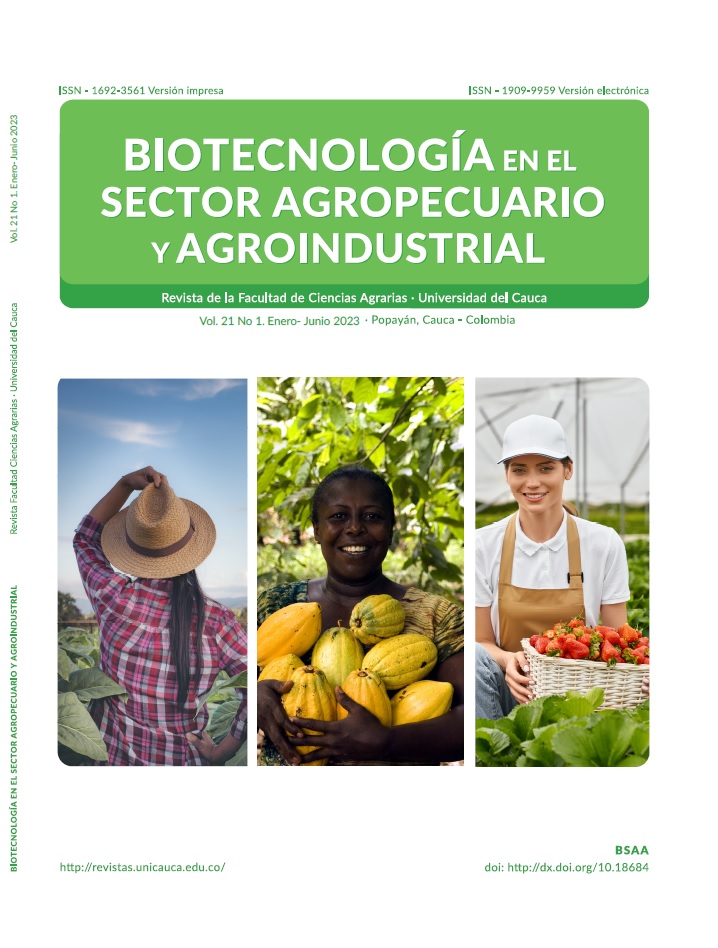Estimación de materiales lignocelulosicos residuales como adsorbentes de cromo y plomo
Resumen
Los materiales lignocelulósicos residuales de origen vegetal pueden usarse como adsorbentes de metales pesados presentes en el agua, propiciando la adsorción de los iones metálicos sobre la superficie y sitios activos de los materiales adsorbentes de origen natural, lo que resulta en una remoción eficiente y de bajo costo. En este caso, los residuos del aprovechamiento agroindustrial del fique (Furcraea macrophilla) y el residuo agrícola del capacho de maíz (Zea mays) se estudiaron como fases adsorbentes de los metales cromo y plomo, con el fin de valorar su capacidad como adsorbente de estos metales presentes en muestras de agua. Los resultados encontrados muestran que la fibra de fique tiene una capacidad de adsorción de Cr y Pb de 7,81 ± 1,40 mg/g y 169,51 ± 1,37 mg/g respectivamente, observando, según los datos experimentales, una forma de isoterma de adsorción tipo Freundlich; mientras que la fibra de capacho de maíz presenta una capacidad de adsorción de 13,35 ± 3,28 mg/g para cromo y 15,01 ± 3,47 mg/g para plomo, mostrando de forma gráfica un comportamiento en su isoterma de adsorción tipo Langmuir.
Descargas
Disciplinas:
Química, Agroquímica, Aprovechamiento AgroindustrialLenguajes:
Español; CastellanoReferencias bibliográficas
[2] F. Lansa Furlan, N. Consolin Filho, M. F. Barriquello Consolin, M. Suzsek Gonçalves, P. Valderrama, and A. Kamal Genena, “Use of agricultural and agroindustrial residues as alternative adsorbents of manganese and iron in aqueous solution,” Ambient. Água, vol. 13, no. 2, pp. 1–12, 2018.
[3] R. R. Singhania, A. K. Patel, and A. Pandey, “Biotechnology for Agricultural Waste Recycling,” in Current Developments in Biotechnology and Bioengineering, 1st ed., J. Wong, R. Tyagi, and A. Pandey, Eds. Hong Kong: Elsevier B.V., 2017, pp. 223–240.
[4] S. Guiza, “Biosorption of heavy metal from aqueous solution using cellulosic waste orange peel,” Ecol. Eng., vol. 99, pp. 134–140, 2017.
[5] G. Blázquez, M. A. Martín-Lara, E. Dionisio-Ruiz, G. Tenorio, and M. Calero, “Evaluation and comparison of the biosorption process of copper ions onto olive stone and pine bark,” J. Ind. Eng. Chem., vol. 17, no. 5–6, pp. 824–833, 2011.
[6] H. T. Tran et al., “Heavy metal biosorption from aqueous solutions by algae inhabiting rice paddies in Vietnam,” J. Environ. Chem. Eng., vol. 4, pp. 2529–2535, 2016.
[7] G. Rocha de Freitas, M. G. C. da Silva, and M. G. Adeodato Vieira, “Biosorption technology for removal of toxic metals: a review of commercial biosorbents and patents,” Environ. Sci. Pollut. Res., vol. 26, pp. 19097–19118, 2019.
[8] A. Bankar and G. Nagaraja, “Recent Trends in Biosorption of Heavy Metals by Actinobacteria,” in New and Future Developments in Microbial Biotechnology and Bioengineering, 1st ed., V. Gupta, Ed. Pune: Elsevier B.V., 2018, pp. 257–276.
[9] S. L. R. K. Kanamarlapudi, V. K. Chintalpudi, and S. Muddada, “Application of Biosorption for Removal of Heavy Metals from Wastewater,” in Biosorption, 1st ed., J. Derco and B. Vrana, Eds. Bratislava: IntechOpen, 2018, pp. 69–116.
[10] S. Shamim, “Biosorption of Heavy Metals,” in Biosorption, 1st ed., J. Derco and B. Vrana, Eds. Bratislava: IntechOpen, 2018, pp. 21–49.
[11] G. Crini and E. Lichtfouse, Adsorbents for Pollutant Removal, 1st ed. Cham: Springer Nature Switzerland, 2018.
[12] A. A. Seolatto, T. D. Martins, R. Bergamasco, C. R. G. Tavares, E. S. Cossich, and E. A. da Silva, “BIOSORPTION STUDY OF Ni2+ AND Cr3+ BY Sargassum filipendula: KINETICS AND EQUILIBRIUM,” Brazilian J. Chem. Eng., vol. 31, no. 01, pp. 211–227, 2014.
[13] “3111 METALS BY FLAME ATOMIC ABSORPTION SPECTROMETRY,” in Standard Methods For the Examination of Water and Wastewater, American Public Health Association, 2018.
[14] I. Vishan, B. Saha, S. Sivaprakasam, and A. Kalamdhad, “Evaluation of Cd(II) biosorption in aqueous solution by using lyophilized biomass of novel bacterial strain Bacillus badius AK: Biosorption kinetics, thermodynamics and mechanism,” Environ. Technol. Innov., vol. 14, pp. 1–14, 2019.
[15] K. S. W. Sing et al., “Reporting physisorption data for gas/solid systems with special reference to the determination of surface area and porosity,” Pure Appl. Chem., vol. 57, no. 4, pp. 603–619, 1985.
[16] A. A. Beni and A. Esmaeili, “Biosorption, an efficient method for removing heavy metals from industrial effluents: A Review,” Environ. Technol. Innov., vol. 17, p. 100503, 2020.
[17] S. Srivastava and P. Goyal, Novel Biomaterials Decontamination of Toxic Metals from Wastewater, 1st ed. Berlin: Springer-Verlag, 2010.
[18] S. Papirio et al., “Heavy Metals Removal from Wastewaters by Biosorption: Mechanisms and Modeling,” in Sustainable Heavy Metal Remediation: Principles and Processes, 1st ed., vol. 8, E. R. Rene, E. Sahinkaya, A. Lewis, and P. N. L. Lens, Eds. Cham: Springer International Publishing, 2017, pp. 1–288.
[19] M. Farnane et al., “New Sustainable Biosorbent Based on Recycled Deoiled Carob Seeds: Optimization of Heavy Metals Remediation,” J. Chem., vol. 2018, pp. 1–16, 2018.
[20] M. Chávez Sifontes and M. E. Domine, “Lignina, estructura y aplicaciones: métodos de despolimerización para la obtención de derivados aromáticos de interés industrial,” Av. en Ciencias e Ingenería, vol. 4, no. 4, pp. 15–46, 2013.
Derechos de autor 2020 Universidad del Cauca

Esta obra está bajo una licencia internacional Creative Commons Atribución-NoComercial-SinDerivadas 4.0.


 Español
Español Inglés
Inglés





















.png)



